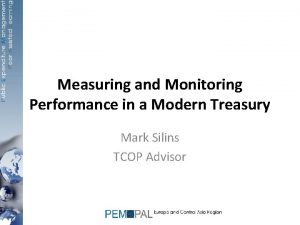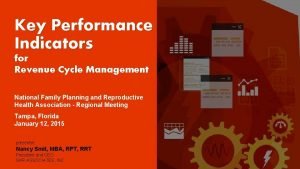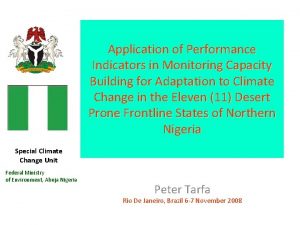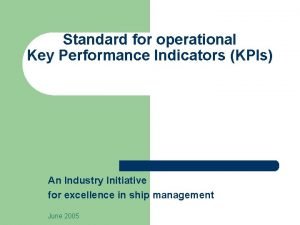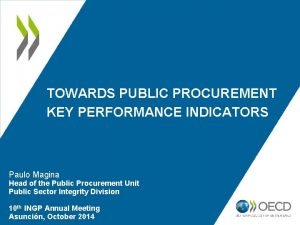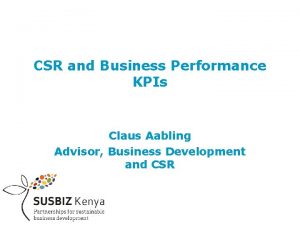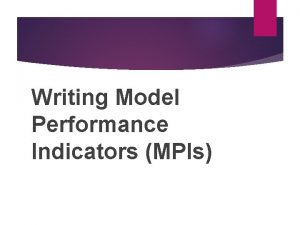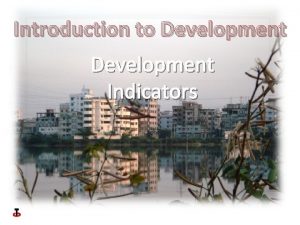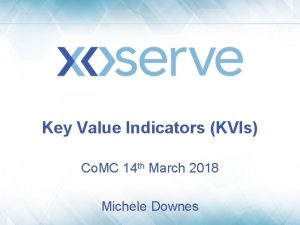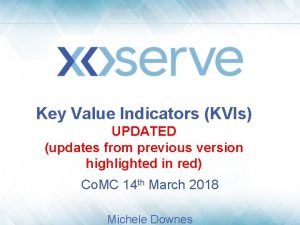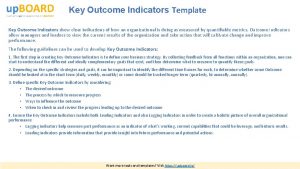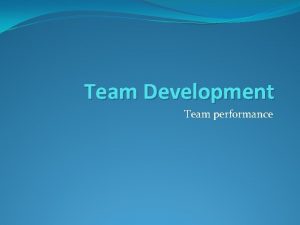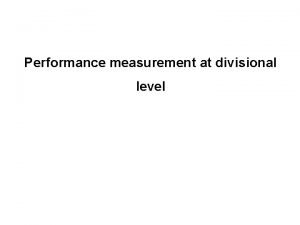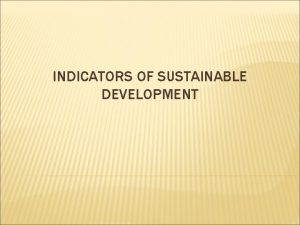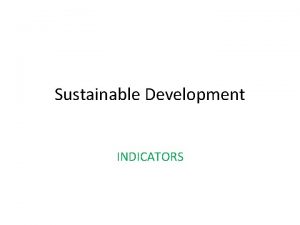Development of key performance indicators for the SDIP









































- Slides: 41


Development of key performance indicators for the SDIP… Introduced by: Sudkey Dweekat Ameer Risheh Yasmin Abu Alhala Majd Mousa Supervised by : Eng. Sulaiman Daifi.

Contents Problem Analysis Project Objective Project Scope Deliverables Conclusion Recommendations

Strategic development and investment planning (SDIP) Localized S. P. approach Identifying local development objectives, priority projects Aspirations & needs of community, available resources & potential opportunitie s and challenges.

A five-phase approach: 1. Where are we now? 2. Where do you want to go from here? 3. How do you get from where you are today to where you want to be in the future? 4. How will you close the gap? 5. How will we monitor & evaluate?

Experts & (consultants) Setting the organizational structure

Where are we now? “Consultants’ Job” Diagnosing thematic areas Preparing a diagnostic report

Diagnostic Report of KPI An important tool to diagnose. Should follow a certain criteria.

What's going on around? Different suggested set of indicators Different experts are being consulted scattered efforts are regularly implemented Problem

Unbalanced decision making process. Decision A Decision B indicator 3 Indicator 2 Indicator 1 indicator 2 indicator 1

Problem Statement The problem of using nonstandard KPIs. Different evaluations and outputs among consultants. Variations in points of view, evaluation, plans, and therefore, decisions and actions. Scattered & wasted efforts.

Project Objective

Project Objective Investigating the Key Performance Indicators (KPI). Check validity & reliability of KPI. Develop current list of KPI. Conduct standard lists of KPI.

Project Scope Strategic Planning and KPIs

Project Scope Health Youth Education Social Affairs Transportation Agriculture Water Civilian Defense Electricity Solid Waste

KPI Should Be Extracted from deep understanding for the targeted aspect. Simple, clear, and measurable. Limited number to facilitate tracking them by decision makers. Practical and applicable. Kept for reasonable interval (3 -5 years) before replacing.

Deliverables Methodology & Sectors

Methodology Select the sector Literatur e review Availabl e KPIs Meet consultants

Methodology Initial list Review Final list Feedback & Evaluation

Deliverables Selected sectors with their indicators

Education Sector A B 1 st Grade Attendance. Achievement Level In Mathematics. # of teachers/grade. Availability of First-Aid Bags. Repetition rate. School dropout rate. Availability of Clinic Per School. Share of school class/ student. # of Rented Classrooms.

Electricity Sector A Percentage of houses unconnected to electricity. Average electricity consumption per capita. Demand factor. System reliability. B Average time for programmed disconnections per KVA. Frequency of programmed disconnections per KVA. Time average of external disconnection in the system.

Social Affairs Sector Percentage of families below poverty line that received aid. Percentage of poor students having exemption from school fees. Percentage of martyrs’ families how receive social aid. Percentage of children obtaining care and protection. Percentage of prevalence of violence against children.

Youth Sector Number of election candidates from youths. Number of projects managed by youths. Percentage of unemployment and poverty within youths. Percentage of budgets customized for investment in youths. Number of youths with Thalassemia.

Transportation Sector Lengths of roads for a town (km). Lengths of roads in the structural plan. Lengths of main roads for a town (km). Percentage of paved roads. Road density (km/km^2). Percentage of roads in a good condition.

Water Sector Proportion of people who have water networks. Average of water quantity available daily for a person. Proportion of people who have water networks & continuous water pumping. Average of wasted water. Percentage of people that their consumption exceeds 100 litres/ day. water

Health Sector A No. of reported births. Spending rate on the health sector. No. of disables per 1000 people. No. of education and health awareness sessions. B Average of the population increase. Mortality rate/100 people No. of public health centres. No. of TB cases per 1000 people.

Civil Defense Sector Availability of civil defense center. Number of firefighters /citizen. readiness of civil defense buildings. Conscious about issues of civil defense and disaster management. infrastructure in fields of accidents investigations.

Waste Water Sector No. of cesspits. Proportion of houses connected with waste water networks. Availability of waste water treatment stations. No. of complaints related to environmental problems. Proportion of people served by refinery station.

Agricultural Sector Agricultural production. Area of organic lands. Number of goats. Area of applicable land for agricultures. Areas with fruit crops.

Solid Waste Sector Number of bins in an agglomeration. Solid waste weight (ton/day). Quantity of collected wastes from each agglomeration. Awareness about waste separation. Number of solid waste's vehicles.

Conclusion

KPIs are used to: Reduce the number of decisions that are based on instinctive perspectives. Quantify the goals by setting, monitoring and measuring against a standard or target. Make decisions based on objectivity and facts. Compare current state with desired state.

Different KPIs Ambivalent opinions Different Methodolog y

Consultant 1 Consultant 2

Standard KPIs Continual Improvement Standard Methodolog y

Consultant 1 Consultant 2 Consultant 3

Recommendations What is next?

Recommendations Cover the rest of the sectors, e. g. economic, women… Get/set standard values each indicator. Continue Researching. Search for and create new indicators. Update indicators.

What is next? Adaptation Apply Evaluation & feedback

 Sdip psychiatrie
Sdip psychiatrie Treasury kpi metrics
Treasury kpi metrics Kpi.com
Kpi.com Revenue cycle kpi
Revenue cycle kpi Key performance indicators engineering
Key performance indicators engineering Key performance indicators for capacity building
Key performance indicators for capacity building Key performance indicators for shipping industry
Key performance indicators for shipping industry Sample kpi for project engineer
Sample kpi for project engineer Pki performance key indicators
Pki performance key indicators Rpms mentoring and coaching
Rpms mentoring and coaching Raquel anido
Raquel anido Wida model
Wida model Csr performance indicators
Csr performance indicators Chapter 7 sports and entertainment marketing
Chapter 7 sports and entertainment marketing Model performance indicators
Model performance indicators Academic performance indicators
Academic performance indicators What is wida standards
What is wida standards Development indicators
Development indicators Media development indicators
Media development indicators Development indicators
Development indicators Fiduciary investment risk management association
Fiduciary investment risk management association Key value indicators
Key value indicators Key value indicators
Key value indicators Key financial indicators
Key financial indicators What are key activities in a business model
What are key activities in a business model Contoh bisnis model canvas makanan pdf
Contoh bisnis model canvas makanan pdf Fspos
Fspos Typiska drag för en novell
Typiska drag för en novell Tack för att ni lyssnade bild
Tack för att ni lyssnade bild Vad står k.r.å.k.a.n för
Vad står k.r.å.k.a.n för Varför kallas perioden 1918-1939 för mellankrigstiden
Varför kallas perioden 1918-1939 för mellankrigstiden En lathund för arbete med kontinuitetshantering
En lathund för arbete med kontinuitetshantering Kassaregister ideell förening
Kassaregister ideell förening Personlig tidbok för yrkesförare
Personlig tidbok för yrkesförare Sura för anatom
Sura för anatom Densitet vatten
Densitet vatten Datorkunskap för nybörjare
Datorkunskap för nybörjare Stig kerman
Stig kerman Debatt mall
Debatt mall För och nackdelar med firo
För och nackdelar med firo Nyckelkompetenser för livslångt lärande
Nyckelkompetenser för livslångt lärande Påbyggnader för flakfordon
Påbyggnader för flakfordon

